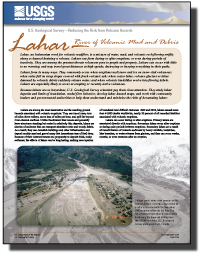Lahar—River of volcanic mud and debris
Links
- Document: Report (5.3 MB pdf)
- Companion File: Video (18 MB)
- Download citation as: RIS | Dublin Core
Abstract
Lahar, an Indonesian word for volcanic mudflow, is a mixture of water, mud, and volcanic rock flowing swiftly along a channel draining a volcano. Lahars can form during or after eruptions, or even during periods of inactivity. They are among the greatest threats volcanoes pose to people and property. Lahars can occur with little to no warning, and may travel great distances at high speeds, destroying or burying everything in their paths.
Lahars form in many ways. They commonly occur when eruptions melt snow and ice on snow-clad volcanoes; when rains fall on steep slopes covered with fresh volcanic ash; when crater lakes, volcano glaciers or lakes dammed by volcanic debris suddenly release water; and when volcanic landslides evolve into flowing debris. Lahars are especially likely to occur at erupting or recently active volcanoes.
Because lahars are so hazardous, U.S. Geological Survey scientists pay them close attention. They study lahar deposits and limits of inundation, model flow behavior, develop lahar-hazard maps, and work with community leaders and governmental authorities to help them understand and minimize the risks of devastating lahars.
Suggested Citation
Major, J.J., Pierson, T.C., and Vallance, J.W., 2018, Lahar—River of volcanic mud and debris: U.S. Geological Survey Fact Sheet 2018–3024, 6 p., https://doi.org/10.3133/fs20183024.
ISSN: 2327-6932 (online)
| Publication type | Report |
|---|---|
| Publication Subtype | USGS Numbered Series |
| Title | Lahar—River of volcanic mud and debris |
| Series title | Fact Sheet |
| Series number | 2018-3024 |
| DOI | 10.3133/fs20183024 |
| Publication Date | May 09, 2018 |
| Year Published | 2018 |
| Language | English |
| Publisher | U.S. Geological Survey |
| Publisher location | Reston, VA |
| Contributing office(s) | Cascades Volcano Observatory |
| Description | Report: 6 p.; Video |
| Online Only (Y/N) | Y |
| Additional Online Files (Y/N) | Y |


